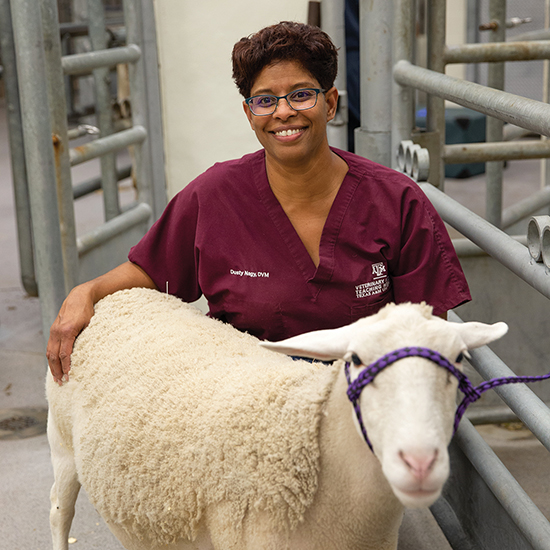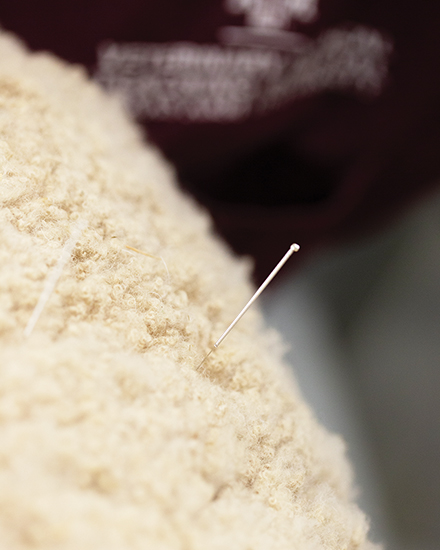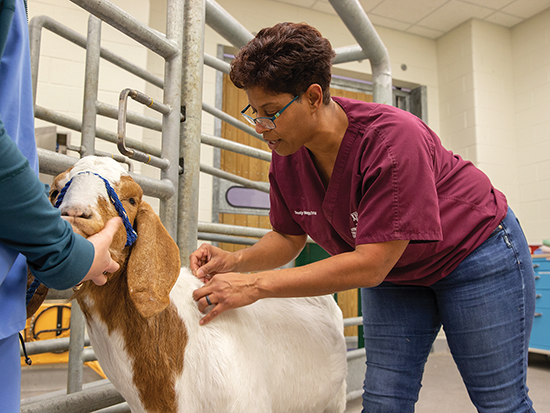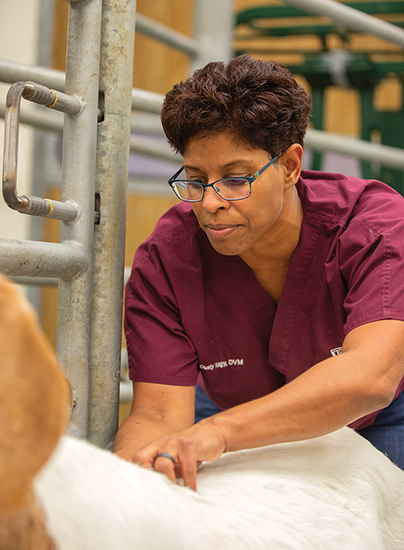Scratching Beneath The Surface
Story by Courtney Adams
Dr. Dusty Nagy’s holistic approach to veterinary care was borne from her personal experiences with chiropractic and acupuncture treatments.

The familiar sound of a mooing cow echoes through the clinic. This time, the noise is not coming from a patient but from Dr. Dusty Nagy’s cellphone.
A bovine lover to her core, Nagy’s passion for her profession radiates from her everywhere she goes.
A clinical associate professor of large animal clinical sciences (VLCS) at the Texas A&M College of Veterinary Medicine & Biomedical Sciences (CVM), Nagy spends her time teaching future veterinarians and treating patients in the clinic, sometimes in uncommon ways.
As a new faculty member, Nagy’s unique work in animal chiropractic medicine and acupuncture makes her an integral part of the team.
Currently, Nagy is the only veterinarian on staff to offer chiropractic care to patients. However, she hasn’t always been a chiropractic “believer.”
In fact, she used to be skeptical of the practice in both humans and animals.
That was until a few years ago, when back pain had taken over Nagy’s work life; she said she had not slept through the night in years.
“My husband and I were trying to figure out how I could retire early because I just couldn’t work anymore,” Nagy said. “It was just too painful.”
One day, Nagy was examining a cow when she suddenly felt the all-too-familiar debilitating back pain.
“All I was doing was palpating a cow. I wasn’t even doing something stupid, by my standards,” Nagy said, with a laugh.
In agony, she fell to the floor, where she would stay for the next two hours.
To appease her technician, Nagy went to the hospital, only to be offered pain medication, a remedy she did not desire. Upon returning to work, the receptionist, who had been badgering Nagy for years to see her chiropractor, had already made Nagy an appointment.

“I looked her dead in the face, and I said, ‘I don’t even care if they kill me. I will go because I can’t do this anymore.’ And I went and I got the most thorough exam I had ever gotten from a doctor that I can remember,” Nagy said.
After her initial appointment, Nagy returned to the chiropractor a couple of days later for her first adjustment. For the first time in years, she slept through the night.
“It turned me into an absolute believer that when applied appropriately, chiropractic treatment can be useful. My experience and outcome made me go, ‘You know what? Maybe I should learn more about this,’” Nagy said. “I decided to learn acupuncture because with production animals, we do not have a lot of options for pain control, and I thought that this would be a good tool to add to my toolbox. What I realized in class is that acupuncture can be used in animals for a variety of conditions.”
Today, Nagy uses acupuncture and chiropractic treatments on many animals; she has seen how both can help improve the quality of life and longevity of her patients.
“Most often, I think people seek out acupuncture for animals in pain or those with behavioral problems,” she said. “I still use acupuncture primarily as an adjunctive treatment along-side western medicine, most often for pain control. When others ask me for an acupuncture consult on a case, it is often for patients that have failed to respond adequately to western medicine and we are attempting to exhaust all of our options.”
Finding Her Path
Nagy grew up in an environment that prepared her for the busy lifestyle of a food animal veterinarian working in an academic setting.
Nagy’s father encouraged her at a young age to remain busy; she was told to find a job—or he would find her one.
So, Nagy spent much of her free time working on farms on the outskirts of the Maryland town in which she lived. Caring for the animals sparked her interest in being a veterinarian.

“I was one of those who decided I wanted to be a veterinarian when I was really small,” Nagy said. “And it stuck. I love what I do; I wouldn’t change it for the world.”
She completed her bachelor’s degree in three years, splitting her time between Colorado State University and the University of Maryland before going directly into Cornell University’s veterinary program. She says she found the first year of veterinary school to be an uphill climb.
“I’m not sure I was ready for that kind of commitment,” Nagy said, remembering how she struggled her first year. “As the years went on, vet school got a lot easier.”
During her last year in veterinary school, Nagy decided to pursue a post-graduate internship and was matched with the University of Missouri, which wasn’t her first choice, but would ultimately turn out to become home.
“It was the program I liked the most, but I didn’t want to go to Missouri,” Nagy said. “I had always thought of it as a fly over state.”
Nagy was only supposed to stay for a year, but toward the end of her internship, the University of Missouri asked her if she would be willing to stay for a residency.
She eventually decided to stay, and about a year and a half into her studies, the program hired a new section head.
“My entire life course changed from the second he walked into the building,” Nagy said. “He tried to convince me to roll my master’s into a Ph.D., and I told him no until the very end of my residency.”
Not only did Nagy go on to complete her Ph.D., but when her husband, who is also a veterinarian, was given the opportunity to complete a diagnostic imaging residency at the University of Illinois, Urbana-Champaign, Nagy’s section head allowed her to accept a faculty position there while completing her doctorate.

Making The Move
After Nagy’s husband finished his residency, the couple contemplated their next step. Nagy interviewed at other places, but “Missouri just really still felt like home,” she said.
And so back to Missouri they went, and there, Nagy was happy, working with people she liked.
“By all accounts, I was going to be there until the end. That was my life plan to stay there. I never, ever thought about moving,” Nagy said.
Throughout her career at Mizzou, she occasionally received calls from colleagues at Texas A&M about job opportunities. During a 2018 call, Nagy was intrigued by the CVM’s new curriculum for veterinary students, but she was still not interested in moving.
That changed when Nagy finally decided she would visit the CVM. Although she viewed the trip more as a way to rid the recruitment phone calls than find a new job, it took only half a day to feel like she would be a fool not to pursue a position at the CVM.
So, what changed Nagy’s mind?
“It’s a great place. There’s so much opportunity here,” Nagy said. “The support is phenomenal. This is an opportunity to finish out the rest of my career in a place of resources.”
Now that she’s at the CVM, Nagy said she looks forward to building a new reputation with her students and clientele in the years to come.
“I was really well-loved by the students at Missouri, and sometimes you go, ’Well, here I am in a brand-new place, and can I actually recreate that? Do I actually do a good job or was it just an urban legend they all believed?’” Nagy said. “You know, it’s not a bad thing to have to prove yourself every now and then.”
###
Note: This story originally appeared in the Spring 2020 edition of CVM Today.
For more information about the Texas A&M College of Veterinary Medicine & Biomedical Sciences, please visit our website at vetmed.tamu.edu or join us on Facebook, Instagram, and Twitter.
Contact Information: Jennifer Gauntt, Director of Communications, Texas A&M College of Veterinary Medicine & Biomedical Sciences; jgauntt@cvm.tamu.edu; 979-862-4216


